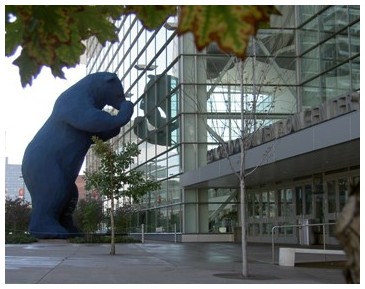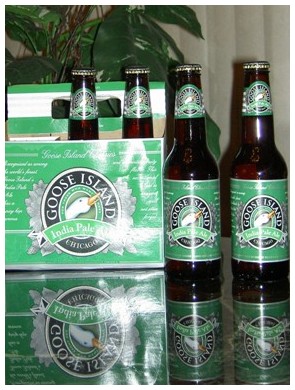The 2010 Great American Beer Festival Rocks Denver

 They arrive at Denver International Airport, flying in from all regions of the country … those American beverage lovers, searching for the newest releases, collaborations, and old classics - all loosely categorized as beer. Of all the thousands of events each year, this is the chart-buster, the magnum opus, the crème de la crème. It is the Great American Beer Festival, the Crown Jewel of the Brewers Association - the Crown Jewel of the Beer World. There are other beer fests across the globe, but this one lives as the nonpareil.
They arrive at Denver International Airport, flying in from all regions of the country … those American beverage lovers, searching for the newest releases, collaborations, and old classics - all loosely categorized as beer. Of all the thousands of events each year, this is the chart-buster, the magnum opus, the crème de la crème. It is the Great American Beer Festival, the Crown Jewel of the Brewers Association - the Crown Jewel of the Beer World. There are other beer fests across the globe, but this one lives as the nonpareil.
Those in-the-know understand its significance as a premier global event. In fact, the importance is so great that brewers and beer aficionados from beyond America’s borders arrive from as far away as New Zealand, England, Guam, Singapore, Belgium, and Germany to taste the most creative beers in the world. The 29th Great American Beer Festival, presented by the Brewers Association, opens the gates to the Colorado Convention Center from Thursday, September 16th through Saturday evening, September 18th in 2010.
When Charlie Papazian, the Grand Maestro of Beer, first orchestrated this event in 1982, he must have appeared to be the Buffoon of Brew. At the time, there were little more than 50 brewing concerns in the entire country. Held at the Harvest House Hotel in Boulder, the “Great” American Beer Festival highlighted only 40 beers from 22 breweries, with 800 people in attendance.
In 1984, it moved to Denver, but did not move to the Colorado Convention Center until 2000. Sometime in the early years, the festival shared venues with other events. In one of our many conversations, Beer Hunter Michael Jackson recalled one such venue where “stage moms,” preening their miniature Cinderellas for a Little Miss Beauty Pageant, shrunk back in horror as the big, bad, beer-focused crowd poured into the very same elevators they were using to transport their little princesses. Although it seems like a scene from a comedy movie, those days settle as ancient history in the Archives of Ale. The American Craft Brewing Renaissance, inspired by such names as Michael Jackson, Fritz Maytag, Jack McAuliffe, Fred Eckhardt, Bert Grant, and Papazian himself, has changed the landscape of beer in the United States, opening the imagination of brewers from coast-to-coast, and inspiring renewed spirit in countries who preserve the traditions of Reinheitsgebot, yet dare to dabble on the fringes of style.
The American Craft Brewing Renaissance, inspired by such names as Michael Jackson, Fritz Maytag, Jack McAuliffe, Fred Eckhardt, Bert Grant, and Papazian himself, has changed the landscape of beer in the United States, opening the imagination of brewers from coast-to-coast, and inspiring renewed spirit in countries who preserve the traditions of Reinheitsgebot, yet dare to dabble on the fringes of style.
Each region in the United States has inspired its own identity: West Coast IPA, Southern Pecan or Sweet Potato Beer, East Coast Extreme, and Midwest German Traditional Lager. Alaska produces Altbier smoked with alder wood, and Hawaii brings Coconut Porter. Belgian styles live in every corner of the country, acting as ambassadors who convert wine drinkers into beer geeks.
The Great American Beer Festival now showcases more than 2,200 beers, served by approximately 462 breweries, in the Great Hall at the Colorado Convention Center. Throughout four sessions, 36,000 gallons of craft beer, enough to fill four tanker trucks, will be served in one-ounce pours to whet the palates of hard-core beer lovers. Tickets for the 2010 GABF sold out a full 5 weeks in advance. A record 49,000 attendees, including volunteers, judges, brewers, the media, and ticket holders, will have access to the Brewers Association event that serves to educate as much as it does to entertain. Four Pavilions will serve as anchors on the festival floor: The Support Your Local Brewery Pavilion, Upgraded Farm to Table Pavilion for Brewers Association and American Homebrewers Association members, Beer and Food Pavilion, and Brewers Studio Pavilion. Both the Beer and Food Pavilion and the Brewers Studio Pavilion will present shows on the half-hour, showcasing notable brewers, chefs, political activists, and beer ambassadors in 30-45 minute spots. The Great American Beer School serves to teach attendees about the world of beer, flavor profiles, how to get the most from the craft beer experience, pairing beer with food, and what books might supplement exploration.
Four Pavilions will serve as anchors on the festival floor: The Support Your Local Brewery Pavilion, Upgraded Farm to Table Pavilion for Brewers Association and American Homebrewers Association members, Beer and Food Pavilion, and Brewers Studio Pavilion. Both the Beer and Food Pavilion and the Brewers Studio Pavilion will present shows on the half-hour, showcasing notable brewers, chefs, political activists, and beer ambassadors in 30-45 minute spots. The Great American Beer School serves to teach attendees about the world of beer, flavor profiles, how to get the most from the craft beer experience, pairing beer with food, and what books might supplement exploration.
In 2010, the festival begins a new segment called the Short Pour Film Festival, that includes animation shorts, music videos, live action shorts, and original commercials from the global market. Silent Disco continues as a popular part of the festival, as well as the You Be The Judge Booth, manned by experienced GABF judges who coach attendees in the fine points of judging beer. The American Homebrewers Association will be on-hand to discuss the how-to-brew details, as well as providing guidance in seeking local clubs for support.
The GABF hosts the Pro-Am Competition in which professional brewers paired with home-brewers create entries that are judged in the professional segment of the beer competition. Three medals will be awarded. Eighty beers will compete in the 2010 Pro-Am. The Pro-Am Booth on the festival floor will feature 20 of these beers, giving festival attendees the opportunity to pick their own winner from the available entrees.
In the background, the Great American Beer Festival holds the Granddaddy of all Beer Competitions as 3,594 craft beers compete in the professional face-off, for 246 medals in 82 categories. One-hundred-fifty judges will assess these beers in a blind competition over 5 sessions lasting 2-1/2 days, kicking-off earlier in the week, and concluding with the awarding of medals during the Saturday afternoon session.
Cheers!
Photos are (from top): The Colorado Convention Center, home of the Great American Beer Festival; Charlie Papazian and Bob Pease of the Brewers Association, and John Hickenlooper, Mayor of Denver, Colorado; Goose Island IPA
You Should Also Read:
Beer Events Before & After the GABF 2010 in Denver
Six Tips - Doing the Great American Beer Festival
2010 WBC - Large Categories & Surprising Stats

Related Articles
Editor's Picks Articles
Top Ten Articles
Previous Features
Site Map
Content copyright © 2023 by Carolyn Smagalski. All rights reserved.
This content was written by Carolyn Smagalski. If you wish to use this content in any manner, you need written permission. Contact Carolyn Smagalski for details.



